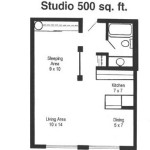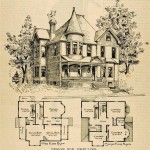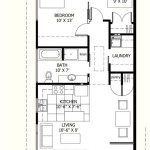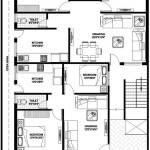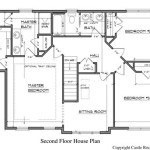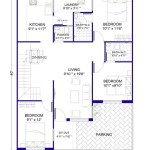House Plans With Simple Roof Lines: An Overview
The roof is a crucial element of any house, providing protection from the elements and contributing significantly to the overall aesthetic. When considering house plans, the roof design is a key determinant of both cost and visual appeal. Simple roof lines offer a compelling combination of affordability, ease of construction, and timeless style. This article explores the advantages of house plans that incorporate simple roof lines, delves into different types of simple roof designs, and discusses factors to consider when selecting a plan with a simple roof.
Advantages of Simple Roof Lines in House Plans
Opting for a house plan featuring simple roof lines provides several significant benefits. These advantages touch upon various aspects of home construction and ownership, ranging from initial building costs to long-term maintenance.
One of the primary advantages is cost-effectiveness. Simple roof designs, such as gable or hip roofs without complex dormers, valleys, or pitches, generally require less material and labor to construct. This translates directly into lower building expenses, making simple roof lines an attractive option for budget-conscious homeowners. The reduced complexity simplifies the framing process, requiring fewer specialized skills and decreasing the time needed for completion. This can further reduce labor costs and minimize delays.
Ease of construction is another notable benefit. Simpler roof designs are inherently easier to build, especially for contractors with varying levels of experience. The straightforward geometry and fewer intricate details minimize the potential for errors during construction. This simplified building process can also reduce the likelihood of future problems, such as leaks or structural weaknesses. The readily available materials and standardized construction techniques associated with simple roofs contribute to a smoother and potentially faster building process.
Furthermore, simple roof lines typically require less maintenance compared to more complex designs. The absence of intricate valleys and numerous junctions reduces the areas where water can accumulate and cause damage. This decreased exposure to the elements diminishes the risk of leaks, rot, and other weather-related problems. Inspecting and repairing a simple roof is also generally easier and less expensive than dealing with a complex roof system. The accessibility of simple roof surfaces also facilitates tasks such as cleaning gutters and removing debris.
Finally, simple roof lines can offer a timeless aesthetic. While trends in architecture may come and go, the clean lines and understated elegance of simple roofs endure. Gable and hip roofs, in particular, have a classic appeal that complements a wide range of architectural styles. This versatility makes them a suitable choice for both traditional and modern homes. The simple, uncluttered appearance of these roofs helps to create a sense of harmony and balance, contributing to the overall curb appeal of the house.
Types of Simple Roof Designs
Several different types of roof designs fall under the category of "simple," each with its own characteristics and suitability for different architectural styles. Understanding these different types allows for a more informed decision when selecting a house plan.
The gable roof is one of the most common and recognizable roof designs. Characterized by its two sloping sides that meet at a ridge, it provides good drainage and is relatively easy to construct. Gable roofs can be utilized with various pitches, allowing for flexibility in design. The simple triangular shape offers ample attic space, which can be utilized for storage or even converted into living space. Gable roofs are well-suited to climates with moderate rainfall and snowfall. They are a cost-effective choice due to their straightforward construction and readily available materials.
The hip roof is another popular choice, featuring slopes on all four sides that meet at a ridge. This design provides excellent stability and wind resistance, making it a suitable option for areas prone to high winds. Hip roofs generally require more materials and are slightly more complex to build than gable roofs, but they offer superior structural integrity. The sloping sides also provide better water runoff and minimize the impact of sun exposure on the walls. Hip roofs are a versatile design that complements a variety of architectural styles.
A shed roof, also known as a skillion roof, features a single sloping surface. This simple design is often used for additions, sheds, and modern homes. Shed roofs are relatively inexpensive to construct and provide effective drainage. They are particularly well-suited for homes designed with a minimalist or contemporary aesthetic. Shed roofs can also be used to create interesting architectural details, such as clerestory windows that allow natural light to enter the building. The simplicity of the design makes it a popular choice for DIY projects.
A flat roof, despite its name, is not perfectly flat. It has a slight slope to allow for water runoff. Flat roofs are commonly found in modern and contemporary designs. While they offer a simple aesthetic, they require careful attention to waterproofing to prevent leaks. Flat roofs can be used as a roof deck or garden, providing additional outdoor living space. The simple design allows for easy installation of solar panels and other rooftop equipment. However, flat roofs may require more maintenance than other types of simple roofs.
Factors to Consider When Choosing a House Plan With a Simple Roof
While simple roof lines offer numerous advantages, it's crucial to consider several factors before selecting a house plan. These considerations include the local climate, the desired architectural style, and the overall budget.
Climate is a key factor in determining the most suitable roof design. In areas with heavy snowfall, a steeper pitch on a gable or hip roof is essential to facilitate snow removal and prevent roof collapse. In regions with strong winds, a hip roof offers better structural integrity and wind resistance. In hot climates, a lighter-colored roof can help to reflect sunlight and reduce cooling costs. The local building codes and regulations may also dictate specific requirements for roof design, such as minimum pitch or material standards. Considering the climate conditions and adhering to local regulations will ensure that the roof provides adequate protection and performs optimally.
The desired architectural style also plays a significant role in roof selection. Gable roofs are often associated with traditional or farmhouse styles, while hip roofs are commonly used in ranch or craftsman homes. Shed roofs are well-suited for modern or contemporary designs. The roof design should complement the overall aesthetic of the house and contribute to its visual harmony. Selecting a roof that aligns with the architectural style will create a cohesive and aesthetically pleasing result. The roof design should also be consistent with the surrounding neighborhood and maintain the overall character of the area.
Budgetary constraints are always a major consideration. Simple roof designs are generally more affordable than complex ones, but the cost can still vary depending on the materials, size, and complexity of the roof. Obtaining multiple quotes from different contractors is essential to ensure that the price is competitive and reasonable. It's also important to factor in the long-term maintenance costs associated with different roof designs. While a simple roof may have lower initial costs, it may require more frequent repairs or replacements if it's not properly maintained. Considering both the upfront costs and the long-term maintenance expenses will help in making an informed decision that aligns with the budget.
Finally, it's crucial to consider the potential for future expansion or modifications. If there's a possibility of adding an addition to the house in the future, the roof design should be adaptable and allow for seamless integration. A simple roof design can make it easier to add dormers, skylights, or other features without significantly altering the structural integrity of the roof. Planning for future needs will ensure that the house remains functional and adaptable over time.
In conclusion, house plans with simple roof lines offer a practical and aesthetically pleasing solution for homeowners seeking affordability, ease of construction, and timeless style. By carefully considering the advantages of simple roof lines, exploring the different types of simple roof designs, and taking into account factors such as climate, architectural style, and budget, homeowners can select a house plan that meets their needs and enhances the overall value and appeal of their home. The key is to prioritize functionality, durability, and aesthetic coherence throughout the planning and construction process.

Simple Rooflines 92024vs Architectural Designs House Plans

Traditional House Plans Monster

Traditional Style With 3 Bed Bath New House Plans

Traditional House Plans With Fresh Twists Houseplans Blog Com

Plan 80864 Style Modern Farmhouse With 1698 Sq Ft 3

Bungalow House Plans Floor Designs Thd

Est House Plans To Build Simple With Style Blog Eplans Com

Easy To Build Houses And Floor Plans Houseplans Blog Com

Spacious And Open Best Floor Plans For Families Blog Homeplans Com

Family Home Plans We Love Blog Eplans Com

